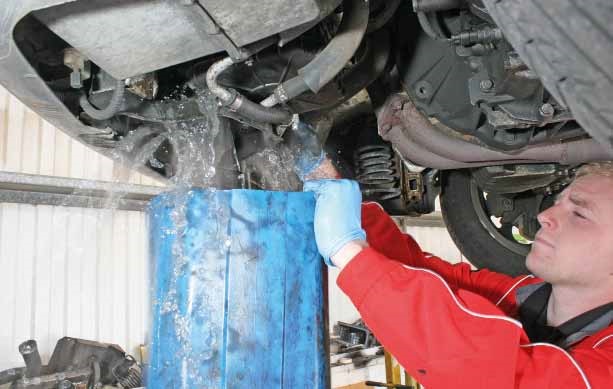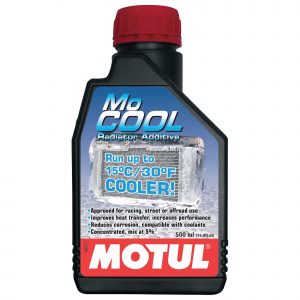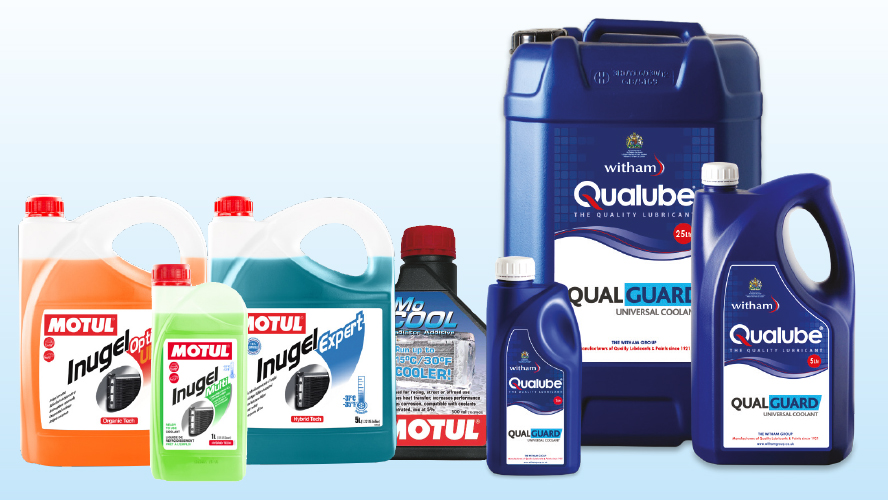Engine coolant issues explained in Classics Monthly article

We were very pleased to see the Witham Group and Motul featured in the August issue of Classics Monthly magazine in their maintenance and servicing guide to Coolants.
How often should your engine’s coolant be renewed? Can you use a different colour coolant in your engine? What’s the best means of flushing the system? These are just some of the questions that the Classic’s Monthly maintenance and servicing guide provides answers to. Also featuring advice from Witham Group’s Technical Director, Mick Keynon.
Coolant issues
An engine’s coolant has quite a
demanding job. It needs to be able to withstand freezing temperatures to avoid
the risk of turning into a solid, which could cause internal damage to the
engine, such as fracturing a waterway and causing it to leak. During the
summer, it needs to maintain the engine’s temperature to ensure it doesn’t get
too hot, along with help from the radiator and a mechanical or electric cooling
fan. And the coolant also needs to prevent internal corrosion of the engine,
which can otherwise result in porous waterways and a build up of silt that can
block outlets and the water pump.
Most classic cars from the
mid-nineties or before use a blue-coloured coolant (also called antifreeze),
such as Witham Group’s Qualube Universal Blue Anti-Freeze, which is available
in one, five and 25 litre containers. As Witham’s Technical Director, Mick
Kenyon explains, “Coolants are made up of a combination of finely balanced
additives that each have a specific role in the quality of the product. Water
acts as the main heat-transfer fluid moving heat away from the engine block.
Monoethylene Glycol (MEG), an organic compound, is added as it also provides
heat-transfer but most importantly it lowers the freezing point and raises the
boiling point of the water. Without MEG or a similar organic molecule, coolant
would freeze readily and subsequently damage the engine.”

Water and MEG on their own would
be corrosive to metals within the cooling system, such as cast iron, aluminium
or solder. So rust would quickly block the cooling system and overheating would
occur.
“Additives are used to prevent corrosion,” says Mick. “In the case of the Qualube Universal Blue this is an example of an inorganic additive technology product (IAT). This means that the chemicals that protect against corrosion are inorganic in nature, such as borates, silicates and nitrates. Inorganic chemicals are mined from the earth and refined. IAT is a tried and tested classical method for protection.”
Later and more modern engines,
such as the Rover K-series that’s used in the MGF and TF, can use a
longer-lasting silicate-free, organic acid technology (OAT) based coolant. So
should you stick with what the manufacturer recommends?
“It is a very broad question as to
why an Original Equipment Manufacturer (OEM) will specify their preferences,”
explains Mick. “In some cases OAT coolant may be chemically unsuitable with the
older classic cars, I would recommend a hybrid or IAT over an OAT for classic
cars. Qualguard hybrid is a premium product and would be perfectly suitable
here as well as across a wide range of applications.”
There’s also some confusion over
the colour of coolant and its lifespan. For instance, blue-coloured coolant is
generally regarded as lasting for two years before it needs changing, whereas
pink-coloured coolant lasts for six years, but as Mick warns, “This is broadly
true but colour is purely cosmetic and gives no indication of the technology or
quality of the product. I would be wary about making decisions based purely on
colour.”
Mick offers some useful guidance
concerning some specific coolants, such as the green-coloured liquid used in a
number of classic Jaguars. “The classic Jags were running on BASF G48 which is
a nitrite-free hybrid coolant and we have a direct equivalent to this in our
range (C2270). Whether you wish to stock another grade or not I couldn’t say,
personally I would use the direct equivalent if I had a classic Jag myself.
However, a full change over from the green to the blue would be possible.”
Renewal Intervals
The recommended intervals for
changing coolant appear to be around two years for blue-coloured coolant and
six years for pink. However, it’s worthwhile testing the freezing and cooling
capacity of the coolant at every service interval (at least once a year) to
check its condition. This can be done with a simple anti-freeze hydrometer that
costs from around £10 upwards from motor factors and tools suppliers such as
Machine Mart.
Whilst checking the coolant, it’s
also worthwhile checking over the cooling system of the engine, by squeezing
hoses to look for perishing, inspecting all connections for traces of leaks
(e.g. residue) and looking around the radiator for similar leaks. Hose clips
should be sufficiently tight to prevent leaks, but Jubilee clips and similar
clips must not be overtightened as they can cut into the rubber and create a
leak.
Most coolant hoses are made of
rubber and are specifically designed for coolant – other hoses such as a
breather hose will deteriorate rapidly and leak or blow-off under pressure.
Steel coolant pipes and similar connections can corrode and leak, often
beginning with a tiny hole that only allows coolant to escape when it’s warm
and under pressure. “Quality coolant will protect against steel corrosion,”
says Mick. “However I would still recommend rubber hoses as being most suitable.”
A pressure cap may be fitted on
the top of the radiator or onto an expansion tank. It helps to raise the
boiling point by an additional 25°C by increasing the pressure in the cooling
system as the engine warms up (the higher the pressure, the higher the boiling
point).
“‘The boiling point of coolant is dependent on the ratio
of concentrate to water that is used,” explains Mick. “Typically this is a
50-50 mix and will have a boiling point of around 110°C at atmospheric
pressure.” So by increasing the pressure in the cooling system, the boiling
point can be raised.
This pressurised coolant system
reduces the risk of the coolant expanding and leaking out when it warms up,
although there may be an overflow tank to collect the extra coolant when it
warms up and draw it back in when it cools down.
The pressure in the coolant system
of an engine is released when the engine is switched off and left to cool down.
This is the job of the pressure cap, which has a spring and valve on the
underside to control the pressure. However, if the valve has failed, it may
allow coolant to leak out when the engine is running and up to temperature,
resulting in coolant loss and potential overheating. Renewing the pressure cap
is part of the recommended service schedule for some cars.
Renewing Coolant
The general aim of renewing engine
coolant is to remove the old liquid and refill the system with a fresh mix of
anti-freeze and coolant (pre-mixed coolant is also available). The ratio of
water to anti-freeze varies, depending on the desired freezing capability you need
– the greater the proportion of anti-freeze, the lower the freezing point,
although as Mick warns, “Don’t go above two parts antifreeze to one part water,
the quality and freeze protection would be lower.” And Mick offers some useful
advice on the water used in a cooling system, “I would always recommend the use
of deionised or distilled water for dilution, this is what comes in the premix
product. The products are designed to tolerate dilution with hard water but if
the water in your region is especially hard there could be a greater tendency
for silt formation.”
There are some exceptions to this advice, such as Motul MoCool, which is a non-glycol-based additive for use in race engines where a glycol-based product cannot be used. In such circumstances, the engine may only be run for a few minutes, such as at a hillclimb event, so the cooling system may be very simple with no water pump to help maximise engine power. Witham explain that by adding Motul MoCool, it helps the engine to run up to 15°C cooler and improves thermal exchange and engine cooling system efficiency.

The starting point for renewing
engine coolant is to determine how you are going to drain the old coolant.
There may be several drain points, such as a drain tap on the engine block and
the bottom of the radiator and heater. If there aren’t any of these, or they
are seized, then releasing a lower coolant hose from the engine and the bottom
of the radiator can be just as effective. Remember to open any heater valves or
switch the heater to hot to ensure the coolant is drained out of it – and this
is also essential for refilling.
The coolant that is removed from
an engine’s cooling system must be carefully disposed of at a council recycling
facility. Coolant is poisonous and can kill animals and seriously harm humans
if it is drunk (ingested), although a bittering agent is added to help avoid
this.
Draining the system by releasing
drain taps or hoses probably won’t remove all of the old coolant and certainly
won’t remove all of the silt that may be present.

Instead, try flushing fresh water
from a hosepipe through a hose or outlet to help flush out the remaining
coolant and any silt. Alternatively, an engine flush could be added to the
coolant before draining it, which requires the engine to be run to help
breakdown and loosen any silt.
Flushing the coolant system may
not be sufficient is a radiator or heater matrix is choked with silt, in which
case it’s worthwhile removing it and attaching the hosepipe to one end.
The expansion tank can benefit
from being removed and cleaned with a hosepipe and bottle brush. Silt and dirt
can build up inside, blocking the outlets, which can result in the tank being
full, but the rest of the system empty, resulting in overheating.
Switching
Changing to a different colour and
type of coolant isn’t so straightforward and the two must never be mixed as
they can congeal, potentially resulting in blocked waterways and a blocked
water pump.
“Compatibility between chemicals
is a wide-reaching topic,” says Mick. “Coolant technologies are formulated to
give protection to the system in isolation and a mixture of two different types
of technology will typically be of lower quality than either on their own. In
extreme cases the additives may be chemically incompatible with one another and
a reaction could occur, this can lead to gel formation or interfere with the
corrosion protection of the product.”
So our flushing advice must be
followed if you intend to change the type/colour of coolant.
When you’re ready to refill the
coolant system with fresh coolant, try to see how the air in the coolant system
is going to escape. There may be some bleed screws that can be undone, for
example. Ideally, these need to be situated at a high point on the engine or
car, but they can be extended by attaching a hose to the outlet of the bleed
screw. This is the recommended means of renewing the coolant on the Mk1 Toyota
MR2, where there are coolant pipes with bleed screws under the front
compartment. The front of the car has to be raised and hoses attached to these
bleed screws when refilling the coolant system.
Whether there are bleed screws or
none at all, make sure the heater is switched to hot, any pressure caps are
removed, then start to refill the system via points such as the radiator and
expansion or header tank. The thermostat will restrict the flow of coolant, but
it should force its way through and allow the air to escape via the bleed
screws, radiator and expansion tank. However, the engine may need to be run to
help refill the system and remove any remaining air.
When running the engine, watch the temperature gauge, check the heater gets warm and look for air bubbles escaping via the radiator or expansion tank. It may take 10-15 minutes for the engine to warm up to temperature and for all the remaining air to escape. That remaining air can cause air locks, so carefully check all heater hoses are warm (use an infrared thermometer instead of touching them and risking being burnt). If an air lock is suspected or found, then it needs to be removed, which can be time-consuming. Running the engine at high revs may help to force it out as the water pump will rotate faster at higher engine revs but watch the coolant temperature gauge. Pressurising the system with a pressure tester is a safer means. This involves pumping the coolant system to increase its pressure using a hand pump before releasing a bleed screw to see if any air escapes. It’s usually used for pressure testing the coolant system but can help to remove an air lock. Budget for around £40 for a universal pressure test kit.
Witham Group Coolants
The Witham Group offers a choice of antifreeze and coolants to suit all budgets and performance needs. Take a look at our online shop for more details.





Coolants are very necessary to maintain vehicle temperature and cooling the engine. These are made by mixing coolant and water and also help in reducing corrosion.